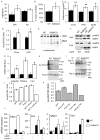SirT1 gain of function increases energy efficiency and prevents diabetes in mice
- PMID: 18840364
- PMCID: PMC3222897
- DOI: 10.1016/j.cmet.2008.08.014
SirT1 gain of function increases energy efficiency and prevents diabetes in mice
Abstract
In yeast, worms, and flies, an extra copy of the gene encoding the Sirtuin Sir2 increases metabolic efficiency, as does administration of polyphenols like resveratrol, thought to act through Sirtuins. But evidence that Sirtuin gain of function results in increased metabolic efficiency in mammals is limited. We generated transgenic mice with moderate overexpression of SirT1, designed to mimic the Sirtuin gain of function that improves metabolism in C. elegans. These mice exhibit normal insulin sensitivity but decreased food intake and locomotor activity, resulting in decreased energy expenditure. However, in various models of insulin resistance and diabetes, SirT1 transgenics display improved glucose tolerance due to decreased hepatic glucose production and increased adiponectin levels, without changes in body weight or composition. We conclude that SirT1 gain of function primes the organism for metabolic adaptation to insulin resistance, increasing hepatic insulin sensitivity and decreasing whole-body energy requirements. These findings have important implications for Sirtuin-based therapies in humans.
Conflict of interest statement
The authors declare no competing financial interests.
Figures




References
-
- Accili D. Lilly lecture 2003: the struggle for mastery in insulin action: from triumvirate to republic. Diabetes. 2004;53:1633–1642. - PubMed
-
- Baur JA, Pearson KJ, Price NL, Jamieson HA, Lerin C, Kalra A, Prabhu VV, Allard JS, Lopez-Lluch G, Lewis K, Pistell PJ, Poosala S, Becker KG, Boss O, Gwinn D, Wang M, Ramaswamy S, Fishbein KW, Spencer RG, Lakatta EG, Le Couteur D, Shaw RJ, Navas P, Puigserver P, Ingram DK, de Cabo R, Sinclair DA. Resveratrol improves health and survival of mice on a high-calorie diet. Nature. 2006;444:337–342. - PMC - PubMed
-
- Bordone L, Cohen D, Robinson A, Motta MC, van Veen E, Czopik A, Steele AD, Crowe H, Marmor S, Luo J, Gu W, Guarente L. SIRT1 transgenic mice show phenotypes resembling calorie restriction. Aging Cell. 2007;6:759–767. - PubMed
-
- Fasshauer M, Klein J, Neumann S, Eszlinger M, Paschke R. Adiponectin gene expression is inhibited by beta-adrenergic stimulation via protein kinase A in 3T3-L1 adipocytes. FEBS Lett. 2001;507:142–146. - PubMed
Publication types
MeSH terms
Substances
Grants and funding
- R01 CA098821/CA/NCI NIH HHS/United States
- F32 DK079496/DK/NIDDK NIH HHS/United States
- DK07328/DK/NIDDK NIH HHS/United States
- R01 CA085533/CA/NCI NIH HHS/United States
- T32 DK007328/DK/NIDDK NIH HHS/United States
- HL87123/HL/NHLBI NIH HHS/United States
- P60 DK020541/DK/NIDDK NIH HHS/United States
- P01 HL087123/HL/NHLBI NIH HHS/United States
- P30 DK063608/DK/NIDDK NIH HHS/United States
- DK63608/DK/NIDDK NIH HHS/United States
- DK079496/DK/NIDDK NIH HHS/United States
- DK64819/DK/NIDDK NIH HHS/United States
- DK20541/DK/NIDDK NIH HHS/United States
- R01 DK064819/DK/NIDDK NIH HHS/United States
- P30 DK020541/DK/NIDDK NIH HHS/United States
- R01 DK057539/DK/NIDDK NIH HHS/United States
LinkOut - more resources
Full Text Sources
Other Literature Sources
Medical
Molecular Biology Databases

